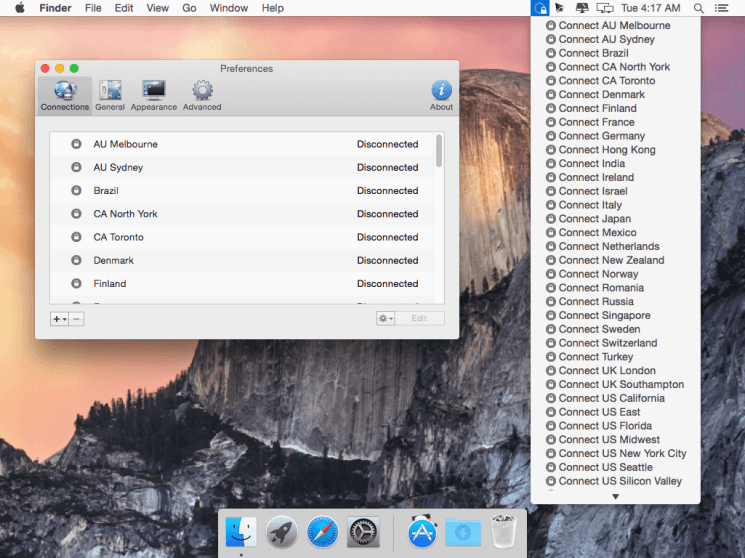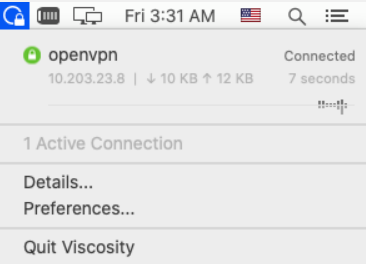

- #VISCOSITY VPN OR OPEN VPN HOW TO#
- #VISCOSITY VPN OR OPEN VPN INSTALL#
- #VISCOSITY VPN OR OPEN VPN FOR WINDOWS 10#
- #VISCOSITY VPN OR OPEN VPN VERIFICATION#
12:39:40: WARNING: No server certificate verification method has been enabled. 12:39:35: 181 variation(s) on previous 100 message(s) suppressed by -mute 12:39:35: machine_readable_output = DISABLED 12:39:35: suppress_timestamps = DISABLED

12:39:35: explicit_exit_notification = 0 12:39:35: tun_mtu_extra_defined = DISABLED 12:39:35: Checking reachability status of connection.

12:39:35: Viscosity OpenVPN Engine Started This is the log I see including one reattempt (with addresses changed): 12:39:35: Viscosity Mac 1.9.3 (1571) It goes from connecting to authenticating and over again. These are valid as by mistyping I get an authentication error :-)īut the connection is never established. When I try to connect I have to provide my user/pwd login - and the VPN password. If I edit it again it just shows "ca.crt", "cert.crt" and "key.key" - but I guess this is Viscosity's way of hiding what I have selected? I have also manually edited the imported connection configuration and selected the CA, Cert and Key certificates (originally created on the MikroTik box - see below). When I set up Viscosity it suggests to import connections from Tunnelblick (nice!) - so I did -) Today I'm using Tunnelblick against our MikroTik router - and it works fine (apart from the VM issues). I'm trying to connect to our company VPN (that I have set up) using Viscosity VPN to try and solve an issue where VMs running on VMware Fusion 12 on MacOS 11.5 don't work any more (Viscosity has been a solution for others according to this discussion). You can easily set up multiple Business Accounts with Multiple IP Addresses from IPBurger.Not sure if this is the right place to ask this question? Please follow: Guide: Perform IP, DNS, and WebRTC Leak Tests Multiple Accounts

#VISCOSITY VPN OR OPEN VPN FOR WINDOWS 10#
To Setup, please follow: Guide: Kill Switch for Windows 10 Perform Leak Tests Kill Switch blocks you from exposing your Real IP Address, if the VPN Connection ever drops. Switch back to the Connections tab, select the connection, and click on Edit.Įnable Connect when Viscosity opens and click Save. Go to General tab and tick the Start Viscosity at Login. You can set up your VPN to automatically connect when you log into your computer.Ĭlick on the Viscosity icon and go to Preferences. If you are having issues connecting, please contact our Support, we are happy to help! Next Steps Auto-Connect Open the downloaded Credentials file and let it import into Viscosity.Īs the installation finishes, IPBurger will start automatically and you will see it in the Tray icons. This will download a profile file for your VPN. Click on the Manage button.Ĭlick on the Download VPN Credentials button, and select OpenVPN. This will download a profile file for your proxy. Login to your account, and find the IP address/Service you want to use.Ĭlick on the Download VPN Credentials button, and select OpenVPN.
#VISCOSITY VPN OR OPEN VPN HOW TO#
Find your OpenVPN credentials from your Service Page.įurther steps shows how to get credentials for: Get OpenVPN credentials for your IP address
#VISCOSITY VPN OR OPEN VPN INSTALL#
Install Viscosity from here: Install ViscosityĢ. Note: If you have already installed the app, then you can skip this step. You need to do it only once.Ĭonnect to VPN with Viscosity 1. Follow Guide: Prevent DNS Leaks in Windows 8 and 10. In Windows 8 & 10, new Smart DNS features are known to cause DNS Leaks.


 0 kommentar(er)
0 kommentar(er)
